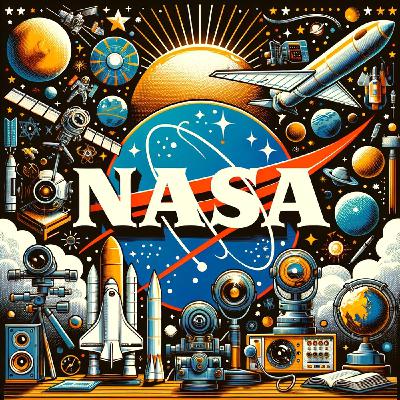NASA Launches TRACERS, Artemis II Advances, and Workforce Changes Amid Budget Boost
Update: 2025-07-28
Description
The most significant story from NASA this week is the successful launch of the TRACERS mission, a groundbreaking step for space weather research. On Wednesday, NASA’s twin Tandem Reconnection and Cusp Electrodynamics Reconnaissance Satellites, better known as TRACERS, blasted off from Vandenberg Space Force Base aboard a SpaceX Falcon 9. These satellites are set to unravel the mysteries of Earth’s magnetic shield and how it protects us from solar storms and other space weather events. According to NASA’s science team, the next month will be spent calibrating and checking out each satellite’s systems before their year-long prime mission officially begins.
Alongside TRACERS, three smaller experimental satellites—Athena EPIC, PExT, and REAL—also launched, each focused on testing new technologies and gathering data that could shape future missions. NASA’s Acting Administrator Sean Duffy highlighted the momentum this week, noting progress on Artemis II preparations. The agency completed its final ground system verification for Artemis II by testing a new liquid hydrogen tank at Kennedy Space Center, a critical step toward returning humans to the Moon. Crew-11, with astronauts from NASA, JAXA, and Roscosmos, is also slated for its International Space Station departure later this week, underscoring NASA’s deepening partnerships with both international and private sector collaborators.
Looking at policy and funding, President Biden’s 2025 budget proposal allocates $25.4 billion for NASA, a modest 2% increase over last year. Notably, Earth Science sees a 12% bump in funding, recognizing the growing importance of climate monitoring, while deep space exploration expenses remain steady. Administrator Bill Nelson said, “An investment in NASA is an investment in America for the benefit of humanity,” reflecting the agency’s dual mandate of exploration and improving life on Earth. However, not all the news is rosy—reports from the American Astronomical Society note workforce reductions and the closure of three NASA offices following a White House executive order, a move raising concerns about future science budgets.
For Americans, these developments mean improved space weather forecasting, with practical benefits for power grid security, satellite safety, and even airline reliability. US companies gain opportunities as NASA invests in new technologies and systems, while state and local governments—especially in launch states like California and Florida—see boosts in jobs and STEM engagement programs. Globally, NASA’s collaboration with partners, as evidenced by the international Artemis crew, keeps the United States at the forefront of space diplomacy and scientific leadership.
Listeners can get involved by following NASA’s upcoming media events, submitting questions through #AskNASA, or engaging with education initiatives connected to Artemis and TRACERS. Big changes are on the horizon, with milestones like the Artemis II crewed lunar mission and a year of new scientific discoveries from TRACERS just ahead.
Keep your eyes on the skies—for next week’s Artemis II crew arrival, TRACERS mission updates, and the latest on the Crew-11 launch. For more information, visit nasa.gov or follow their official social channels. If you have questions or thoughts, NASA often invites public input on its projects. Thanks for tuning in, and don’t forget to subscribe for future episodes. This has been a Quiet Please production, for more check out quietplease dot ai.
For more http://www.quietplease.ai
Get the best deals https://amzn.to/3ODvOta
This content was created in partnership and with the help of Artificial Intelligence AI
Alongside TRACERS, three smaller experimental satellites—Athena EPIC, PExT, and REAL—also launched, each focused on testing new technologies and gathering data that could shape future missions. NASA’s Acting Administrator Sean Duffy highlighted the momentum this week, noting progress on Artemis II preparations. The agency completed its final ground system verification for Artemis II by testing a new liquid hydrogen tank at Kennedy Space Center, a critical step toward returning humans to the Moon. Crew-11, with astronauts from NASA, JAXA, and Roscosmos, is also slated for its International Space Station departure later this week, underscoring NASA’s deepening partnerships with both international and private sector collaborators.
Looking at policy and funding, President Biden’s 2025 budget proposal allocates $25.4 billion for NASA, a modest 2% increase over last year. Notably, Earth Science sees a 12% bump in funding, recognizing the growing importance of climate monitoring, while deep space exploration expenses remain steady. Administrator Bill Nelson said, “An investment in NASA is an investment in America for the benefit of humanity,” reflecting the agency’s dual mandate of exploration and improving life on Earth. However, not all the news is rosy—reports from the American Astronomical Society note workforce reductions and the closure of three NASA offices following a White House executive order, a move raising concerns about future science budgets.
For Americans, these developments mean improved space weather forecasting, with practical benefits for power grid security, satellite safety, and even airline reliability. US companies gain opportunities as NASA invests in new technologies and systems, while state and local governments—especially in launch states like California and Florida—see boosts in jobs and STEM engagement programs. Globally, NASA’s collaboration with partners, as evidenced by the international Artemis crew, keeps the United States at the forefront of space diplomacy and scientific leadership.
Listeners can get involved by following NASA’s upcoming media events, submitting questions through #AskNASA, or engaging with education initiatives connected to Artemis and TRACERS. Big changes are on the horizon, with milestones like the Artemis II crewed lunar mission and a year of new scientific discoveries from TRACERS just ahead.
Keep your eyes on the skies—for next week’s Artemis II crew arrival, TRACERS mission updates, and the latest on the Crew-11 launch. For more information, visit nasa.gov or follow their official social channels. If you have questions or thoughts, NASA often invites public input on its projects. Thanks for tuning in, and don’t forget to subscribe for future episodes. This has been a Quiet Please production, for more check out quietplease dot ai.
For more http://www.quietplease.ai
Get the best deals https://amzn.to/3ODvOta
This content was created in partnership and with the help of Artificial Intelligence AI
Comments
In Channel





